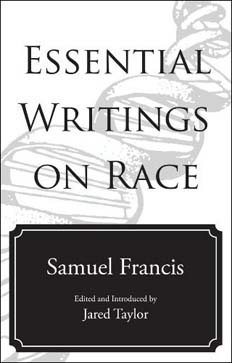Obscuring the True Sam Francis
Chris Roberts, American Renaissance, September 8, 2016
The last year has been a good one for the legacy of Sam Francis. While usually either ignored or maligned by the media during his career, the success of Donald Trump has forced many to show him a modicum of respect. Liberal John Judis and conservative Michael Brendan Dougherty cited Francis at length in their sociological examinations of Trump supporters published in National Journal and The Week, respectively, and both linked to by Real Clear Politics. More recently Milo Yiannopoulos mentioned him in his examination of the “Alt Right,” and he was referred to frequently in the flash-in-the-pan pro-Trump website Journal of American Greatness (JAG). The release of Francis’s posthumous book Leviathan and Its Enemies has received yet more notice, with the liberal scholar of conservatism, Sam Tanenhaus, tweeting praise of the book, and a lengthy mention of it in The Guardian.

Sam Francis
This is all good; Sam Francis was a brilliant man well worth reading. However, most references to him have a glaring flaw: They evade or dismiss his racial views. Mr. Judis, Mr. Dougherty, Mr. Tanenhaus, and JAG all treat with great respect Francis’s theory of “Middle American Radicals” (MARs) and his distinctly right-wing view of class conflict, but none explains the theory in the explicitly racial terms in which Francis always presented it. This misinterpretation of Francis is likely to continue as reviews of Leviathan begin circulating, since the book is not explicitly racial.
Mr. Judis danced around race in his essay, “The Return of the Middle American Radical,” simply noting that MARs have gone from supporting explicitly racialist candidates such as George Wallace, to more implicit ones such as Pat Buchanan and Donald Trump. Mr. Dougherty and the writers at JAG go to greater lengths to separate the sociology of MARs from the biology of whiteness, with lines such as, “Francis eventually turned into a something resembling an all-out white nationalist, penning his most racist material under a pen name.” By writing this, Mr. Dougherty attempts to separate the Sam Francis of Chronicles magazine and the Pat Buchanan campaigns, and the Sam Francis of American Renaissance and The Occidental Quarterly. This split is an invention.
To begin with, consider the chronology. Sam Francis, a charter subscriber to American Renaissance, began receiving the magazine in 1990. Jared Taylor even discussed AR with Francis before he began publishing it, and did so with Francis’s strong encouragement. Francis therefore had an interest in white identity well before Pat Buchanan’s first presidential bid in 1992. Furthermore, the decade of 1990 – 2000, which saw the bulk of Francis’s paleoconservative writing and activism, was the same decade that saw the blossoming of his racial consciousness. Sam Francis spoke at the very first American Renaissance conference in 1994, where he called for white racial consciousness very explicitly:
As long as whites continue to avoid and deny their own racial identity, at a time when almost every other racial and ethnic category is rediscovering and asserting its own, whites will have no chance to resist their dispossession and their eventual possible physical destruction. Before we can seriously discuss any concrete proposals for preserving our culture and its biological and demographic foundations, we have to address and correct the problem we inflict on ourselves, our own lack of a racial consciousness and the absence of a common will to act in accordance with it.
This was no sudden venture into racial consciousness but a reflection of long-settled views. That speech also preceded his now widely cited, and more strictly paleoconservative, essay “From Household to Nation” by a year and a half. The 1990s saw many other speeches and articles by Francis for American Renaissance. Mr. Dougherty is correct to say that Francis sometimes used a pen name, but again chronology is important. He published “The Roots of the White Man” under a pseudonym, but only because it ranged widely over areas of scholarship in which Francis was not a recognized expert. It appeared in 1996, the same year as “From Household to Nation.” Even a superficial look at the writings of Sam Francis belie the idea that he was no more than a Buchananite until the end of the 1990s or even the early 2000s.
Some might suggest that even though Francis cared about white identity for at least the last 25 years of his life, his views on the managerial revolution and middle American radicals can be divorced from his convictions about race. After all, Leviathan touches only briefly on race, and the book by which it was most influenced, James Burnham’s The Managerial Revolution, does not mention race at all. But the truth is more complicated.

While the early formation of the managerial elite is a largely raceless process, per both Burnham and Francis, that is not true of the current managerial regime. Both in Leviathan and numerous essays, Francis noted the very strong electoral alliance of the egalitarian, leftist managerial elite, and the non-white underclass, particularly blacks. His vision of middle-American radicals was one of the white Americans outside of and mistreated by both ends of this elite-lumpenproletariat alliance.
Aside from elections, Francis saw the “anti-racism” of managerial forces as an essential component of its power. The moralistic need to purge society of racism, in the eyes of Francis, was an enormous boon to managerial power because it justified the kinds of programs and laws from which managers drew their strength: elaborate and bureaucratic systems of “re-education” to override local, traditional, and bourgeois laws and customs.
Francis reiterates in Leviathan that the managerial elite, unlike most past elites, thrives on change, because it is the class that analyzes, manages, and systematizes change. This comes naturally to it because it lacks loyalty to nation, religion, ethnicity, or indeed, race. Since the 1960s, the greatest change the managerial elite has engineered in the United States is the demographic transformation we have seen over the last half century. This change benefits the elite in many ways. It both displaces and weakens the traditionalist and bourgeois forces in the US, which are overwhelmingly white, and it brings in new people who need to be educated, employed, protected from discrimination, housed, medicated, etc.–all good things for an elite whose power is management and manipulation. In this way, the managerial elite is at the very least implicitly–if not explicitly–anti-white. Replacing one people with another is the ultimate managerial task.
With that in mind, we can answer the question as to why Francis wrote this book on the managerial revolution. He wrote it to dissect the most powerful anti-white force known to man. If you don’t care about whites, the existence of an anti-racist managerial regime is not very terrible, unless you are a very dedicated individualist libertarian or devoutly religious–and Francis was neither. While Francis and Burnham do not dwell much in their respective books about the anti-white nature of the managerial regime, it is clearly expressed in their later writings. Francis addressed it frankly in “Why the American Ruling Class Betrays Its Race and Civilization,” and Burnham did so in his later book, Suicide of the West, a book monumentally more racial than its latter-day conservative promoters would like to admit.
There will be more mentions of Sam Francis, as “Alt-Right” becomes a household word and Leviathan gets more notice, but remember: Francis was a racially conscious white man first and foremost. Anyone who doubts this need only read his collection, Essential Writings on Race.
















